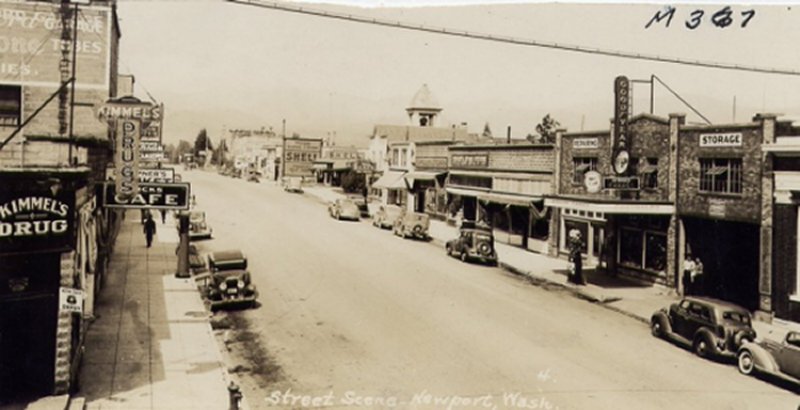
courtesy Pend Oreille County Historical Society
 |
| Newport, Washington Street Scene, circa 1940 courtesy Pend Oreille County Historical Society |
Every part of the country has a unique history; this is the history of the Pend Oreille Valley, an area that was comprised of small towns in extreme northeastern Washington and northwest Idaho. This is a place of interesting cultural diversity that is closely tied to its environment, a place that during World War II provided numerous vital war industries as well as brave young men for the war effort. It is also the story of how people dealt with the adversity of shortages, the loneliness, and the humor that often surrounded them in the four-year period that has many calling them the Greatest Generation. While the experiences of those that lived in the Pend Oreille Valley are not a singularly unique occurrence, this study is exclusive in the fact that this area has often been forgotten in the histories of the region, and as such, this is the first we hear from its residents.
When the Japanese attacked Pearl Harbor, the Pend Oreille Valley was still in the throes of the Depression, with the majority of its residents barely eking out a living in the woods, in the mines, or in the fields. Through these occupations, now deemed essential industries, the residents of the Valley would find themselves helping out the war effort. The timber that in the 1920s and 1930s produced poles for the REA (Rural Electrification Administration) and telephone poles now would be used for the war effort. The mines in the northern part of Pend Oreille County which had long produced lead and zinc for the smelters in Spokane was contributing materials vital for the war. The same with the agricultural products in the Valley, with the milk, cheese, beef, poultry, potatoes, and grains going to not just feed the military, but to feed those on the home front.
As was the entire nation, residents were swept up into defeating our enemies, whether as part of the military or part of the workforce. Many of the young men that could serve did so, in all branches of the service. Many of the young men of the Valley and some of its young women enlisted in the Navy, an organization that recruited heavily in this land-locked area. There were also those that volunteered or were inducted into the Army and Army Air Corps, and there were still a few that volunteered for the Marines. Those men and women that did not serve in the military went to work in the essential industries around the area, places like Diamond Match Sawmill, the Pend Oreille Mine, or went into Spokane to work out at Galena Air Depot, the Alcoa Plant, or Trentwood Aluminum.
Many that look back on that war remember it as a time of minor hardships, a time where you couldn't always get what you wanted, and had to curtail how much you traveled. Those of the "Greatest Generation" remember the difficulty in getting enough sugar, shoes, meat, and stockings, but in the grand scheme of things what wasn't available on the home front was not as bad as it seemed, because after all they didn't have much to begin with. As a result, the gas and tire rationing, the food rationing, and the rationing of shoes, and other clothing wasn't something to worry too much about.
For the young women that were caught up in the rush to marry their sweethearts, and in some cases men they hardly knew, the four years at war was one of terrible loneliness, made especially hard if there were young children involved. However, these women found times to laugh and found that they were not alone, as there were others going through the same things that they were, creating support networks to help them cope.
While none of this is unusual for many small towns in the nation, the proximity to Spokane and Farragut Naval Station would indicate that the Pend Oreille Valley would at least be a footnote in the history of World War II in the Pacific Northwest, and this is not the case. This area, which provided lumber for the building of Farragut, supplied women that worked in Spokane's factories, sent some of its finest young men to fight and inevitably die, as well as serve as host for German and Italian prisoners of war, has been largely ignored, that is until now. Thus, the purpose of this study is to rectify this situation.
The stories and research within are part of an oral history project to complete my master's degree from Eastern Washington University. What follows are the pictures and reminicinces of the Pend Oreille Valley during World War II and the stories of the people that experienced it.
| Copyright © 2004 by Kristen Cornelis |